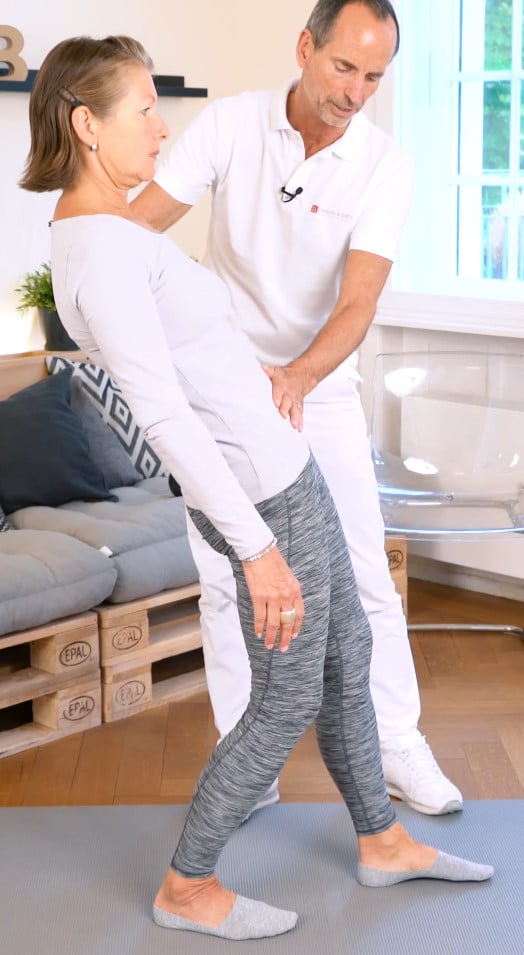Sacroiliac Joint Pain
Exercises for SI joint pain
Body Part:
Pelvis & Buttocks
Equipment:
Midi Massage Ball, Chair
Level:
Beginner
Sacroiliac Joint Pain
Body Part:
Pelvis & Buttocks
Equipment:
Midi Massage Ball, Chair
Level:
Beginner
If you’ve got lower back pain, your back hurts when you stand up after sitting, or you feel pain radiating down your legs, the discomfort may be coming from your sacroiliac joint. According to a recent study, the sacroiliac joint is one of the most common sources of chronic back pain1); it’s also one of the most frequently overlooked causes. 2)
This 8-minute exercise routine targets the tight, stiff muscles and fascia surrounding the sacroiliac joint. Regularly practising our routine can help relieve tension and stiffness and alleviate SI joint pain. All you need for our exercises is a chair and our Midi Massage Ball. If you don’t have our Midi Massage Ball, use a tennis ball. Jump to our routine to start relieving your discomfort, or keep reading to learn more about the sacroiliac joint and SI joint pain.
Below your lumbar spine (lower spine) and above your coccyx (tailbone) is a triangular-shaped bone called the sacrum. Along the right and left sides of the sacrum, running about halfway down, are the sacroiliac joints. The sacroiliac joint attaches the sacrum to the ilium, the biggest and topmost bone in the hip. The sacroiliac joint is the largest synovial joint in our body. 3) Synovial joints are covered by a cartilage layer and kept lubricated by a slippery liquid called synovial fluid. Synovial joints facilitate movement, but the sacroiliac joint only allows for some motion. The joint is stabilized by muscles and ligaments.
The SI joints transfer weight between the spine and lower body, absorb the shock of physical movement and provide stability. Thanks to our SI joints, we can keep our backs straight when we walk and run.
Sacroiliac joint pain is difficult to diagnose. The symptoms of SI joint pain are similar to those of other conditions. The most common symptom is pain in the lower back. Additional symptoms are:
The pain may feel sharp or tingly, or you might experience a feeling of numbness or weakness. The discomfort can occur in one or both of your SI joints.
The following can aggravate SI joint pain:
Standing or sitting for long periods
Standing up after sitting
Running
Stair climbing.
Your sacroiliac joint hurts because it’s inflamed. This is known as si joint dysfunction or sacroiliitis. The inflammation may be the result of:
An injury. Injuries that may cause SI joint inflammation are falls, automobile accidents, and sports injuries. Sacroiliitis is common among runners.
Arthritis. Common forms of arthritis that occur in the SI joint are:
Pregnancy. The weight gain, the physical trauma of giving birth, and the hormonal changes that take place in the body during pregnancy can put you at risk of SI joint pain. 4)
Leg length discrepancy. 5) LLD is a condition where one of your legs is visibly shorter than the other. Most of us have a slight difference in the length of our legs. However, if the difference in length is more than 2 cm, it can affect how you walk, which may lead to SI joint pain.
Scoliosis. Scoliosis causes the spine to curve sideways.
Back surgery. 6)
Sometimes, what causes sacroiliac joint pain isn’t clear.
Visit our online shop to get your Midi Massage Ball. While you’re there, take a look around. We’ve got lots of pain-relieving tools and products waiting to be added to your cart.
Take me to the shop.
You’ll need the Midi Massage Ball for this exercise.

Don’t feel a stretch in your thigh and the front of your hip? Check to make sure your back is straight, and you’re not leaning backwards from your upper back.

Perform our exercises for SI joint pain 6 days a week, leaving 1 day for rest, for a 3-week sprint. Adjust how often you exercise when the pain begins to disappear.
Discover how to rejuvenate your back and hips with our Back Hero. All you have to do is choose the perfect Back Hero stack, lie down, and stretch.
Try Our Back Hero StretchOur Encyclopedia Article includes all you need to know about the sacroiliac (si) joint, and causes and symptoms of si joint pain. Includes more pain-relieving exercises.
Become an SI Joint ExpertGravity is partly responsible for our poor posture. This 4 minute posture correction exercise shows you how to team up with gravity to develop a healthy habit.
Get Healthier Posture Now